There’s no mistaking Harley heritage with this new 2008 Electra Glide Ultra Classic FLHTCU –it’s all around you. There prominently on the tank, backrest, gas cap cover and elsewhere is the 105th Anniversary badge, a reminder that Harley-Davidson began building motorcycles in 1903. And there under the tank is an air-cooled, 45-degree V-twin engine with two valves per cylinder, attributes that can be traced to the very first H-D V-twin introduced back in 1909. But with Harley-Davidson the more things remain the same, the more they change, and that’s how The Motor Company has managed to survive for lo, this century-plus with the basics still intact.
Harley’s success, especially in the past two decades, has been a result of continued incremental change overlaid upon that comfortable, recognizable base. Take the Electra Glide FLH, for example. It was first produced in 1966, and we’ve all grown to recognize its signature fork-mounted, bat-wing fairing. Today, if you were parked beside the road and saw this 2008 Electra Glide Ultra Classic rumble past you, followed immediately by a 1984 Electra Glide Classic, it would take a sharp eye to distinguish between the two. Once they pulled over, however, the differences would leap out at you in multiples.
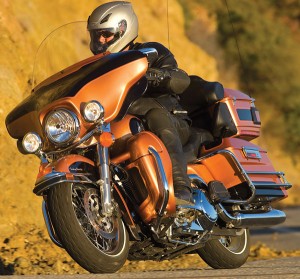
In 1984, features such as Elastomer rubber engine mounting and fully enclosed chain final drive were recent innovations, and the 80-cubic-inch Evolution engine (the one that was to save Harley-Davidson from extinction) had just been introduced. In the intervening years the entire Harley line has gone to belt final drive and electronic fuel injection. The Electra Glide’s fairing has been improved and updated. There’s now a full sound system. The saddlebag lids are now attached and can no longer be lost, the brakes now have four-piston rather than single-piston calipers, and fairing lowers are standard on the Ultra. And in case you feared that the rate of change had slowed in recent years, for 2007 the E-Glide was given the new Cruise Drive six-speed transmission (which debuted on other models the previous year), and the Twin Cam 88-inch engine was upgraded to 96 cubic inches. This was accomplished by leaving the bore intact, but adding almost 10mm to the stroke. For 2008 fuel capacity has grown by one gallon, and various models (including the Ultra) are available with anti-lock brakes. It just goes to show that the rate of change has actually increased in recent years.
That 96-inch motor (1,584cc) offers a bore and stroke of 95.25 x 111.25mm, figures that indicate a torquey stroker rather than a revver. Sure, it’s still air-cooled and its valves are actuated by pushrods with hydraulic lifters that never need adjustment, but power has been tweaked in unexpected ways. Two years ago when we tested the 2006 Ultra Classic its 88-inch Twin Cam motor produced 65 horsepower at 5,700 rpm on the Borla Performance dynamometer, and 67.4 lb-ft of torque at 3,800 rpm. Now, despite gaining 8 cubic inches of displacement, horsepower has actually fallen to 62.4 at 5,200 rpm, but torque is up to 77.8 lb-ft at 3,600 rpm. That’s a whopping 15 percent boost, and anyone who rides a Harley can confirm that torque is what it’s all about. Not only that, but the Ultra’s flat torque curve delivers more than 70 lb-ft from 2,000 on up to 4,400 rpm.
Hit the starter button, and after a loud whump from the starter damper the electronic sequential port fuel injection helps the engine fire up immediately…unless you were foolish enough to forget to pack the hands-free security fob that’s part of the optional Smart Security System. It’s a passive key fob that must be within several feet of the bike or nothing will happen except the turn signals will simply flash at you angrily. When the fob is more than 8 feet away, the security system arms itself and disables the ignition. When the bike is disturbed, the signals flash; a siren alarm is optional. Should you lose the fob or leave it sitting in your garage when you ride off, you can arm or disarm the system by using the turn signal controls to enter a PIN number.
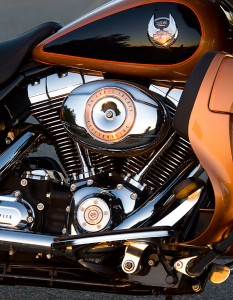
Even when cold the Glide can be ridden away immediately without protest or hiccup. For the 2006 model year, peak clutch lever effort was reduced by 35 percent on Big Twins, and in ’07 touring models got a new clutch cable that resulted in a further 7 percent reduction in effort. The six-speed shifts easily, quickly and with low effort with its heel-and-toe shifter. Gone are the days when one had to pause between shifts on a Harley to allow the parts to properly align.
The Ultra is a traveling machine, which is where it excels. Vibration from the single-crankpin V-twin was tamed long ago, isolated from the rider by rubber engine mounts. The seat is one of the best I’ve ever encountered in motorcycling, a firm base overlaid with soft padding. Typically, I start squirming around within the first 100 miles of a ride, trying to redistribute the pressure points. However, with the Ultra I took a 400-mile weekend ride and it wasn’t until late in the second day that the squirming ritual began. The seat is narrow at the front so the rider can get the feet down at a stop, and the 30.7-inch height is reasonable. Footboards are rubber mounted so that no vibration enters there; the left one is crowded a bit by the heel-and-toe shifter.
The rider sits rather upright behind a full instrument panel that includes a large speedometer and tachometer, and four smaller circular gauges that keep track of fuel supply, charging rate, oil pressure and ambient air temperature. As for entertainment, the Ultra includes a Harman/Kardon 80-watt audio system with AM/FM radio, weatherband, CB, intercom, four speakers, and there’s a power outlet for electric clothing and such. A dizzying list of audio options includes XM Radio, Bluetooth, GPS and a CD changer.
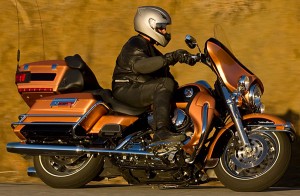
A major factor in pleasant touring is wind protection, and while that classic fairing deflects the wind it also allows a significant amount of buffeting to the rider’s helmet. You won’t be able to hear much of that wonderful audio system at speed unless you utilize helmets with speaker headsets. The Ultra Classic comes standard with a pair of lowers, leg protectors that include a small storage bin under each snap-on cover that can hold a pair of winter gloves.
Each lower also incorporates a curved plastic panel that stows inside. On a cold day the rider can squat in front of the bike and rotate these panels outward on their tracks to block the wind. On warmer days they can be rotated back behind the lowers to allow for more airflow, a good thing since the larger engine now puts out more heat, especially from the rear cylinder exhaust pipe on the right. Likewise, tinted wind deflectors at the edges of the fairing can be rotated inward on warm days to direct airflow to the rider’s body. Both of these comfort items are quite effective.
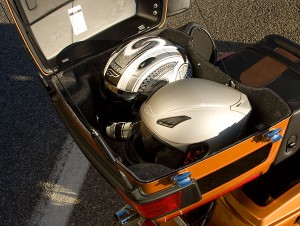
Touring also involves packing, and in my opinion the Harley-Davidson TourPak trunk is the best single piece of motorcycle luggage ever devised. It includes an integral passenger backrest, and because it opens to the side the passenger does not need to scissors forward to clear the lid. It contains a form-fitting insert lined with a flocked material to cushion the load, and the body incorporates LED side lighting. The saddlebags, meanwhile, load easily from the top with their lids removed, and are quite long at 22 inches. My only issue with them is that the bags start large but taper down to only 5-6 inches wide, which can make them difficult to pack. The same key locks the fork, ignition and luggage.
The passenger sits in a true lap of luxury, ensconced against a backrest that’s equipped with wraparound armrests and built-in speakers–the volume control is on the side. The rear seat is as comfy as the rider’s portion, and the feet are placed on fold-out footboards. It all results in a spread-out, settled-in feeling. Just note that the protruding speakers inhibit the ability to carry long items that overlap the seat, such as the tent and camp chair I carried on my weekend sojourn. Your H-D dealer will cheerfully sell you a luggage rack that attaches to the TourPak lid, but lacking that I was able to position these items toward the front of the passenger seat where they cleared the speakers.
The 63.5-inch wheelbase enhances straight-line stability on the highway, where the Ultra can thrum along with the tunes pouring from the stereo speakers and the intercom system allowing the rider to easily speak with the passenger. The full-featured cruise control holds speeds steady across hills and valleys, and can be fine tuned by nudging the thumb control.
With rake/trail figures of a relatively steep 26 degrees combined with a laid-back 6.2 inches, the Glide offers a satisfying blend of surprisingly light, quick steering for a 850-pound motorcycle, with stability. It becomes fun to hustle down a twisty road until it runs smack up against the bane of most Harleys–lack of cornering clearance. Way too soon the sidestand and footboards begin to drag, and cooler heads need prevail; the Glide forces the rider to remain within its cornering limitations or suffer the consequences.
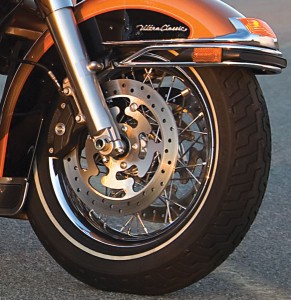
With its three four-piston brake calipers, the days of having to immediately upgrade your Harley brakes are over. Now with the addition of optional anti-lock brakes, things get even better. Head for that patch of gravel across the road, keep the bike upright and nail the brakes. You’ll feel the initial deceleration, a sudden pulsing in the brake lever and pedal as the brakes momentarily release and by contrast the bike almost seems to accelerate across the gravel patch, then immediate reapplication of the brakes and deceleration. All you need to do is maintain pressure on the brakes and the bike does the rest; ABS can save your hog’s bacon (as long as you’re upright rather than leaned over in a corner).
The FLH has an air-adjustable rear suspension, and Harley calls for no additional air pressure for a solo rider of up to 150 pounds, on up to 20-25 psi for a big rider and 200-pound passenger. Air pressure in the system acts as a spring, and the rear suspension is adequately damped. My only comment is that I wished for greater damping in the non-adjustable fork, which moved too readily for my tastes.
With the 9.2:1 compression ratio you’ll run 91-octane (premium) fuel in your Big Twin. Another notable change this year is that fuel capacity has been increased from 5.0 to 6.0 gallons, yet the tank still has a clean look. The 38.4 mpg I recorded during my solo, mostly highway time on cruise control was a bit disappointing, and translates to a range of about 230 miles.
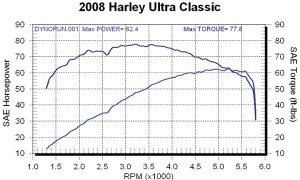 Some riders have a tendency to dismiss Harley-Davidson’s air-cooled twins as antiquated dinosaurs, as overpriced bikes that don’t measure up in terms of technology. Granted, that was true a number of years ago, and today their power and smoothness do not match that of the multicylinder bikes. However, considering that the Ultra is a tourer intended for comfort, luggage carrying and a satisfying ride, the new, better one reminds us not only how far Harley-Davidson has come, but that it’s still moving onward and upward.
Some riders have a tendency to dismiss Harley-Davidson’s air-cooled twins as antiquated dinosaurs, as overpriced bikes that don’t measure up in terms of technology. Granted, that was true a number of years ago, and today their power and smoothness do not match that of the multicylinder bikes. However, considering that the Ultra is a tourer intended for comfort, luggage carrying and a satisfying ride, the new, better one reminds us not only how far Harley-Davidson has come, but that it’s still moving onward and upward.








I have one, 2008 FLHTCUI It is a great bike. Very heavy.